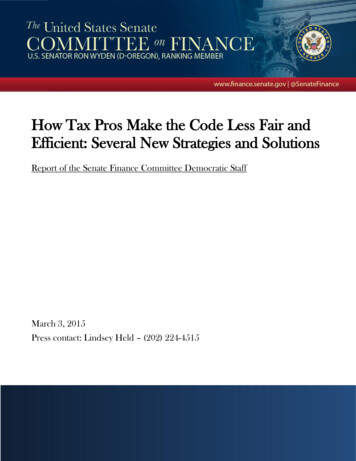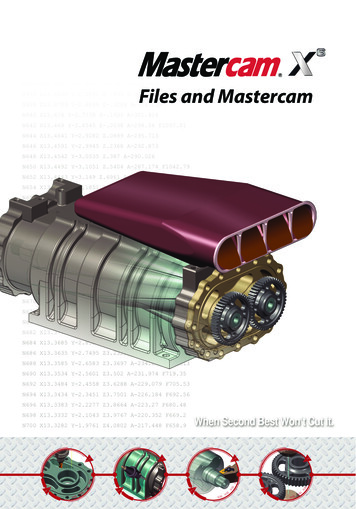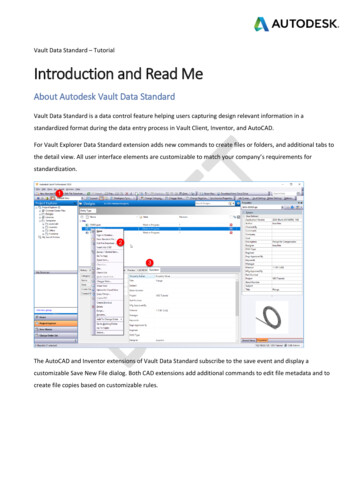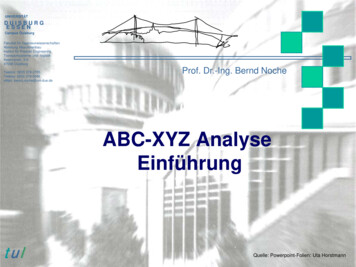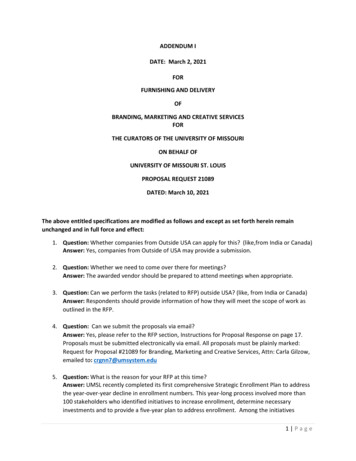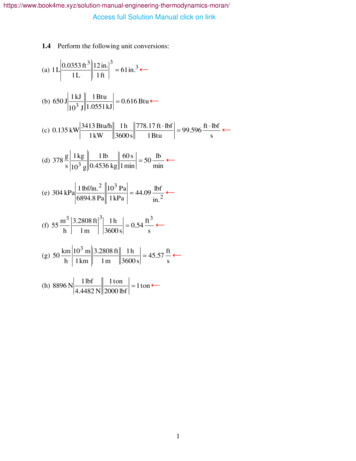
Transcription
g-thermodynamics-moran/Access full Solution Manual click on link1.4Perform the following unit conversions:(a) 1 L0.0353 ft 3 12 in.1L1 ft(b) 650 J 61 in.3 1 kJ1 Btu 0.616 Btu 103 J 1.0551 kJ(c) 0.135 kW(d) 37833413 Btu/h 1 h 778.17 ft lbfft lbf 99.5961 kW3600 s1 Btusg 1 kg1 lb60 slb 50s 10 3 g 0.4536 kg 1 minmin 1 lbf/in. 2 10 3 Palbf 44.096894.8 Pa 1 kPain. 2 (e) 304 kPa3(f) 55m 3 3.2808 fth1m(g) 50km 10 3 m 3.2808 ft 1 hft 45.57 h 1 km1m3600 ss(h) 8896 N1hft 3 0.543600 ss 1 lbf1 ton 1 ton 4.4482 N 2000 lbf1
g-thermodynamics-moran/1.5Perform the following unit conversions:(a) 122 in.31 cm 3(d) 1000(g) 751L 2L 1 kJ 1.0551 kJ 737.56 ft lbf1 kW 74.57 kW 1.341 hplb 1 h1 kgkg 0.126h 3600 s 2.2046 lbs(e) 29.392(f) 250030.061024 in.3 10 2 cm 10 - 3 m 3(b) 778.17 ft lbf(c) 100 hp1mlbf 6894.8 Pa 1 N/m2 1 bar 2.027 bar in.2 1 lbf/in. 2 1 Pa 105 N/m2ft 3 0.028317 m3 1 minm3 1.18min60 ss1 ft 3mile 1.6093 km/hkm 120.7h1 mile/hh(h) 1 ton2000 lbf 4.4482 N 8896 N 1 ton1 lbf1
g-thermodynamics-moran/1.6Which of the following food items weighs approximately one newton?a. a grain of riceb. a small strawberryc. a medium-sized appled. a large watermelon1
g-thermodynamics-moran/1.7 A person whose mass is 150 lb weights 144.4 lbf. Determine (a) the local acceleration ofgravity, in ft/s2, and (b) the person’s mass, in lb, and weight, in lbf, if g 32.174 ft/s2.(a) Fgrav mg g Fgravm 144.4 lbf 32.174 lb ft/s2 30.97 ft/s2150 lb1 lbf(b) Mass value remains the same. Soft 1 lbf Fgrav mg (150 lb) 32.174 2 150 lbfs 32.174 lb ft/s2 1
g-thermodynamics-moran/1.8 The Phoenix with a mass of 350 kg was a spacecraft used for exploration of Mars.Determine the weight of the Phoenix, in N, (a) on the surface of Mars where the acceleration ofgravity is 3.73 m/s2 and (b) on Earth where the acceleration of gravity is 9.81 m/s2.KNOWN: Phoenix spacecraft has mass of 350 kg.FIND: (a) Weight of Phoenix on Mars, in N, and (b) weight of Phoenix on Earth, in N.SCHEMATIC AND GIVEN DATA:m 350 kggMars 3.73 m/s2gEarth 9.81 m/s2ENGINEERING MODEL:1. Acceleration of gravity is constant at the surface of both Mars and Earth.ANALYSIS: Weight is the force of gravity. Applying Newton’s second law using the mass ofthe Phoenix and the local acceleration of gravityF mg(a) On Mars,m 1N 1305.5 NF (350 kg) 3.73 2 s 1 kg m/s 2 (b) On Earth,m 1N 3433.5 NF (350 kg) 9.81 2 s 1 kg m/s 2 Although the mass of the Phoenix is constant, the weight of the Phoenix is less on Mars than onEarth since the acceleration due to gravity is less on Mars than on Earth.1
g-thermodynamics-moran/
g-thermodynamics-moran/
g-thermodynamics-moran/1.11 At the grocery store you place a pumpkin with a mass of 12.5 lb on the produce springscale. The spring in the scale operates such that for each 4.7 lbf applied, the spring elongates oneinch. If local acceleration of gravity is 32.2 ft/s2, what distance, in inches, did the springelongate?KNOWN: Pumpkin placed on a spring scale causes the spring to elongate.FIND: Distance spring elongated, in inches.SCHEMATIC AND GIVEN DATA:m 12.5 mxENGINEERING MODEL:1. Spring constant is 4.7 lbf/in.2. Local acceleration of gravity is 32.2 ft/s2.ANALYSIS:The force applied to the spring to cause it to elongate can be expressed as the spring constant, k,times the elongation, x.F kxThe applied force is due to the weight of the pumpkin, which can be expressed as the mass (m) ofthe pumpkin times acceleration of gravity, (g).F Weight mg kxSolving for elongation, x, substituting values for pumpkin mass, acceleration of gravity, andspring constant, and applying the appropriate conversion factor yieldx mg k 12.5 lb 32.2 ft2 lbf 4.7 in. s 1 lbf 2.66 in.lb ft32.174 2s
g-thermodynamics-moran/
g-thermodynamics-moran/
g-thermodynamics-moran/
g-thermodynamics-moran/1.17 A communications satellite weighs 4400 N on Earth where g 9.81 m/s2. What is theweight of the satellite, in N, as it orbits Earth where the acceleration of gravity is 0.224 m/s2?Express each weight in lbf.KNOWN: Weight of communications satellite on Earth.FIND: Determine weight of the satellite, in N, as it orbits Earth where the acceleration ofgravity is 0.224 m/s2. Express the satellite weight, in lbf, on Earth and in orbit.SCHEMATIC AND GIVEN DATA:WSat(Earth) 4400 NgEarth 9.81 m/s2gorbit 0.224 m/s2ENGINEERING MODEL:1. Gravitational acceleration on Earth is constant at 9.81 m/s2.2. Gravitational acceleration at orbital altitude is constant at 0.224 m/s2.ANALYSIS: Weight of the satellite is the force of gravity and varies with altitude. Mass of thesatellite remains constant. Applying Newton’s second law to solve for the mass of the satelliteyieldsW mg m W/gOn Earth,m WSat(Earth)/gEarthm (4400 N) 1 kg m/s 2 448.5 kg1N m 9.81 s2 Solving for the satellite weight in orbit,WSat(orbit) mgorbitm 1N 100.5 NWSat(orbit) (448.5 kg) 0.224 2 s 1 kg m/s 2 Although the mass of the communications satellite is constant, the weight of the satellite is less atorbital altitude than on Earth since the acceleration due to gravity is less at orbital altitude thanon Earth.1
g-thermodynamics-moran/To determine the corresponding weights in lbf, apply the conversion factor, 1 lbf 4.4482 N.WSat(Earth) (4400 N)1 lbf 989.2 lbf4.4482 NWSat(orbit) (100.5 N)21 lbf 22.6 lbf4.4482 N
g-thermodynamics-moran/
g-thermodynamics-moran/
g-thermodynamics-moran/1.21 A 2-lb sample of an unknown liquid occupies a volume of 62.6 in.3 For the liquiddetermine (a) the specific volume, in ft3/lb, and (b) the density, in lb/ft3.KNOWN: Volume and mass of an unknown liquid sample.FIND: Determine (a) the specific volume, in ft3/lb, and (b) the density, in lb/ft3.SCHEMATIC AND GIVEN DATA:m 2 lbV 62.6 in.3ENGINEERING MODEL:1. The liquid can be treated as continuous.ANALYSIS:(a) The specific volume is volume per unit mass and can be determined from the total volumeand the mass of the liquidv V 62.6 in.3 1 ft 3 0.0181 ft3/lb m2 lb 1728 in.3(b) Density is the reciprocal of specific volume. Thus, 1 v130.0181ftlb 55.2 lb/ft3
g-thermodynamics-moran/
g-thermodynamics-moran/1.23 The specific volume of 5 kg of water vapor at 1.5 MPa, 440oC is 0.2160 m3/kg. Determine(a) the volume, in m3, occupied by the water vapor, (b) the amount of water vapor present, ingram moles, and (c) the number of molecules.KNOWN: Mass, pressure, temperature, and specific volume of water vapor.FIND: Determine (a) the volume, in m3, occupied by the water vapor, (b) the amount of watervapor present, in gram moles, and (c) the number of molecules.SCHEMATIC AND GIVEN DATA:m 5 kgp 1.5 MPaT 440oCv 0.2160 m3/kgENGINEERING MODEL:1. The water vapor is a closed system.ANALYSIS:(a) The specific volume is volume per unit mass. Thus, the volume occupied by the water vaporcan be determined by multiplying its mass by its specific volume. m 3 1.08 m3V mv (5 kg) 0.2160 kg (b) Using molecular weight of water from Table A-1 and applying the appropriate relation toconvert the water vapor mass to gram moles gives 1000 molesm 5 kg 277.5 molesn kg 1 kmolM 18.02 kmol (c) Using Avogadro’s number to determine the number of molecules yieldsmolecules # Molecules Avogadro' s Number # moles 6.022 10 23 (277.5 moles)mole # Molecules 1.671 1026 molecules
g-thermodynamics-moran/
g-thermodynamics-moran/
g-thermodynamics-moran/1.27 Three kg of gas in a piston-cylinder assembly undergo a process during which therelationship between pressure and specific volume is pv0.5 constant. The process begins withp1 250 kPa and V1 1.5 m3 and ends with p2 100 kPa. Determine the final specific volume,in m3/kg. Plot the process on a graph of pressure versus specific volume.KNOWN: A gas of known mass undergoes a process from a known initial state to a specifiedfinal pressure. The pressure-specific volume relationship for the process is given.FIND: Determine the final specific volume and plot the process on a pressure versus specificvolume graph.SCHEMATIC AND GIVEN DATA:State 1State 2Process 1 2GasGaspv0.5 constantm2 3 kgp2 100 kPam1 3 kgp1 250 kPaV1 1.5 m3ENGINEERING MODEL:1. The gas is a closed system.2. The system undergoes a polytropic process in which pv0.5 constant.ANALYSIS:The final specific volume, v2, can be determined from the polytropic process equationp1v10.5 p2v20.5Solving for v2 yields1 p 0.5v2 v1 1 p2 Specific volume at the initial state, v1, can be determined by dividing the volume at the initialstate, V1, by the mass, m, of the systemV1 1.5 m 3 v1 0.5 m3/kgm3 kg1
g-thermodynamics-moran/Substituting values for pressures and specific volume yields1 m 3 250 kPa 0.53 v2 0.5 3.125 m /kgkg 100 kPa The volume of the system increased while pressure decreased during the process.A plot of the process on a pressure versus specific volume graph is as follows:Pressure versus Specific Volume260Pressure pecific Volume (m 3/kg)23.003.50
g-thermodynamics-moran/1.28 A closed system consisting of 4 lb of a gas undergoes a process during which the relationbetween pressure and volume is pVn constant. The process begins with p1 15 lbf/in.2, v1 1.25 ft3/lb and ends with p2 53 lbf/in.2, v2 0.5 ft3/lb. Determine (a) the volume, in ft3,occupied by the gas at states 1 and 2 and (b) the value of n. (c) Sketch Process 1-2 on pressurevolume coordinates.KNOWN: Gas undergoes a process from a known initial pressure and specific volume to aknown final pressure and specific volume.FIND: Determine (a) the volume, in ft3, occupied by the gas at states 1 and 2 and (b) the valueof n. (c) Sketch Process 1-2 on pressure-volume coordinates.SCHEMATIC AND GIVEN DATA:State 1State 2GasGasp2 53 lbf/in.2v2 0.5 ft3/lbm 4 lbp1 15 lbf/in.2v1 1.25 ft3/lbENGINEERING MODEL:1. The gas is a closed system.2. The relation between pressure and volume is pVn constant during process 1-2.ANALYSIS:(a) The specific volume is volume per unit mass. Thus, the volume occupied by the gas can bedetermined by multiplying its mass by its specific volume.V mvFor state 1 ft 3 5 ft3V1 mv1 (4 lb) 1.25 lb For state 2 ft 3 V2 mv2 (4 lb) 0.5 2 ft3 lb 1
g-thermodynamics-moran/(b) The value of n can be determined by substituting values into the relationship:p1(V1)n constant p2(V2)nSolving for np1 V2 p2 V1 ln n V p1 n ln 2 p2 V1 2 p1 ln 15 lbf/in. ln 53 lbf/in. 2 p 1.38n 2 3 V 2 ft ln 2 ln 3 5 ft V1 (c) Process 1-2 is shown on pressure-volume coordinates below:Process 1-260State 2Pressure (lbf/in.2)50403020State 11000123Volume (ft3)2456
g-thermodynamics-moran/
g-thermodynamics-moran/
g-thermodynamics-moran/1.31 A gas contained within a piston-cylinder assembly undergoes four processes in series:Process 1-2: Constant-pressure expansion at 1 bar from V1 0.5 m3 to V2 2 m3Process 2-3: Constant volume to 2 barProcess 3-4: Constant-pressure compression to 1 m3Process 4-1: Compression with pV 1 constantSketch the process in series on a p-V diagram labeled with pressure and volume values at eachnumbered state.p (bar)4 21 3 10.51221V (m3)
g-thermodynamics-moran/
g-thermodynamics-moran/
g-thermodynamics-moran/1.36 Liquid kerosene flows through a Venturi meter, as shown in Fig. P1.36. The pressure ofthe kerosene in the pipe supports columns of kerosene that differ in height by 12 cm. Determinethe difference in pressure between points a and b, in kPa. Does the pressure increase or decreaseas the kerosene flows from point a to point b as the pipe diameter decreases? The atmosphericpressure is 101 kPa, the specific volume of kerosene is 0.00122 m3/kg, and the acceleration ofgravity is g 9.81 m/s2.KNOWN: Kerosene flows through a Venturi meter.FIND: The pressure difference between points a and b, in kPa and whether pressure increases ordecreases as the kerosene flows from point a to point b as the pipe diameter decreases.SCHEMATIC AND GIVEN DATA:patm 101 kPag 9.81 m/s2L 12 cmKerosenev 0.00122 kg/m3 b aENGINEERING MODEL:1. The kerosene is incompressible.2. Atmospheric pressure is exerted at the open end of the fluid columns.ANALYSIS:Equation 1.11 applies to both columns of fluid (a and b). Let hb be the height of the fluid abovepoint b. Then hb L is the height of the fluid above point a. Applying Eq. 1.11 to each columnyieldspa patm g(hb L) patm ghb gLandpb patm ghbThus, the difference in pressure between point a and point b is p pb – pa (patm ghb) – (patm ghb gL) p – gL1
1 1.8 The Phoenix with a mass of 350 kg was a spacecraft used for exploration of Mars. Determine the weight of the Phoenix, in N, (a) on the surface of Mars where the acceleration of gravity is 3.73 m/s2 and (b) on Earth where the acceleration of gravity is 9.81 m/s2. KNOWN: Phoenix spacecraft has mass of 350 kg. FIND: (a) Weight of Phoenix on Mars, in N, and (b) weight of Phoenix on Earth, in N.

